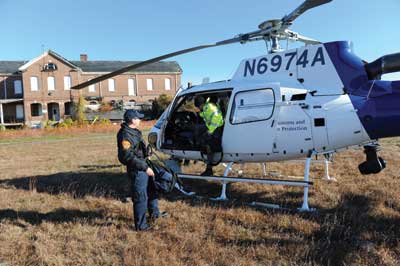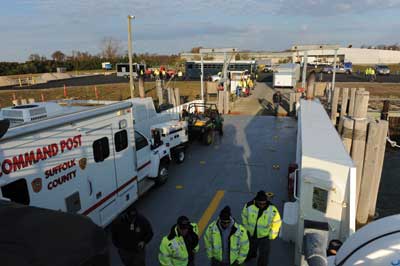BY BRETT M. MARTINEZ
When dealing with catastrophic events, New York State’s Long Island has distinct issues because of its population and its geography. The island of eight million is connected to the continental United States by an aging and limited bridge and tunnel system. Almost all land- and seaborne resupply must travel through New York City, which creates additional bottlenecks, confusion, and delays. These factors complicate disaster response to the island’s communities. In its history, the island has faced frequent catastrophic disasters, natural and manmade [e.g., the 1991 Nor’easter (inspiration for the film The Perfect Storm), the 1996 Boeing 747 TWA Flight 800 crash, the 2012 Super Storm Sandy, and the 2013 100-year blizzard]. Because of this, Suffolk County (the island’s easternmost county) has spent years studying target hazards, developing action plans and protocols, and continuously reassessing its ability to respond during catastrophic events.
One key component is the Suffolk County Urban Search and Rescue Task Force (SC USAR TF), developed as a Type 3 task force, following the Department of Homeland Security (DHS) National Incident Management System (NIMS) typing guidelines. The task force has been developed to provide specialized technical and water rescue capabilities to communities and regions during large-scale catastrophic incidents within Suffolk or neighboring jurisdictions. The SC USAR TF includes emergency medical service (EMS), fire, and law enforcement special operations personnel who train and respond with each other as a unified force.
MOBEX
To ensure its effectiveness, the task force conducts an annual Mobilization Exercise (MobEx) designed so members can practice skills not usually exercised at local drills conducted over only a few hours. As its name implies, MobEx starts from the task force’s activation through mobilization at the point of departure (PoD) to its transport to the affected jurisdiction. On arrival, the task force establishes a base of operations (BoO) before deploying specialty squads, which will continue to function through multiple operational periods (photo 1). On completion of the mission, the task force dismantles the BoO and returns to the PoD to demobilize. Practicing these operations allows the SC USAR TF members to focus on all aspects of deployment, not just on the capabilities of individual members and squads but also on the logistics and planning during a long-duration catastrophic event.
 |
| (1) Photos by Dennis Whittam. |
CHOOSING A SITE
The 2013 MobEx focused on the task force’s ability to deploy to the barrier and smaller outlying islands within Suffolk County’s jurisdiction, which present distinct challenges because of their limited access. The three barrier islands (on Long Island’s South Shore along the Atlantic Ocean) are connected by aging two-lane, single-span bridges to the mainland. The bridges’ weight limitations and stress limitations during high-wind conditions can make access difficult.
The remaining seven islands have no airfields, are accessible only by water, and have just residential and small commercial structures except for one government facility. The SC USAR TF has developed nonconventional methods in preparing to deploy to these smaller communities. Most Type 3 USAR task forces are considered state assets and would not anticipate or prepare moving their assets by air or by water. Federal Emergency Management Agency (FEMA) Type 1 assigned task forces do so because they must be capable of transporting their task force great distances.
For the most part, the SC USAR TF follows this mission plan except when operating within its own jurisdiction for two reasons. Since Long Island is an island, unless resources are prestaged or deployed prior to an event, the possibility for those assets to reach the island’s eastern twin forks is severely limited. Also, it allows any mutual-aid resources that can respond and arrive on scene sooner to assist local assets and to maximize their effectiveness by integrating with the county task force members as it did during Super Storm Sandy (see “Suffolk County USAR Task Force 1 Response,” Fire Engineering, June 2013, http://bit.ly/1iCDh9L).
With all this in mind, the 2013 MobEx design team considered Plum Island for its training site, which provided a tremendous opportunity because it has no private residences, only a government facility operated by the United States Department of Agriculture under the DHS. MobEx operations (e.g., extensive trial-and-error exercises such as loading and unloading vehicles and equipment at the island’s docks and boat terminals and the operation of jackhammers and chain saws) would not inconvenience or disrupt residents.
Plum Island has a full-time staff of more than 350 employees, and its geography has many of the same features as the other surrounding islands. It served as a government military facility from the Spanish-American War (1899) until the 1960s. Located near Orient Point, off the eastern end of the North Fork coast in Gardiners Bay, it is 1.5 miles from Long Island and nine miles from Connecticut. Since it served as a military base, it has many old forts and artillery positions that offer excellent training scenarios for technical rescue operations. Since it is an active research facility, the roadways have been maintained for transport and security patrols. These features offered great opportunities to simulate the SC USAR TF response to the other Suffolk County islands and train under real-world conditions without interfering with actual residential communities.
JOINT PLANNING
The SC USAR TF sought permission to create and facilitate an exercise that would test its members’ ability to deploy, function, and operate on Plum Island for 24 hours under fall and early winter conditions. We held a joint exercise design meeting at which we addressed the concerns of the Plum Island staff and of the task force prior to deployment. The island staff were outstanding partners, explaining the government’s mission on the island and helping us to create a tremendous training exercise. They also integrated the task force’s goals and objectives into the island’s daily operations, establishing access protocols and determining methods of movement for the weekend’s activities.
Because of the security requirements, all task force members were vetted prior to deployment and required to carry their SC USAR TF credentials during their deployment on Plum Island. Since the task force’s planning section branch had maintained accurate personnel records, this was quickly accomplished.
SCENARIO DESIGN
The exercise design staff created scenarios to simulate a civilian community cut off by a large-scale natural disaster similar to Super Storm Sandy, a nor’easter affecting Long Island’s eastern twin forks and the smaller East End Islands. This storm would tax the local community emergency response resources to their limit and require Suffolk County’s western communities to assist the twin fork townships. Since all primary first responders were already assisting the mainland communities, the SC USAR TF would be requested to effect search and rescue missions on the fictitious Plum Island communities of Lost City and the Ranch. To accomplish this, SC USAR TF would need to mobilize and deploy to the island using helicopters and boats, similar to the missions the task force conducted on Long Island and the barrier island during Super Storm Sandy.
Since this would be a logistics-intense MobEx, it required many hours of planning to develop an exercise that focused on the core functions related to deployment and would incorporate land, sea, and air transport. The land transport would involve the standard transport methods of 11 vehicles including the task force tractor trailer, heavy-duty pickup trucks pulling smaller utility trailers, a mobile command unit, and personnel transport vans. Since the ground vehicles would only take the task force so far, the transport plan also included using aviation and sea assets.
The aviation assets were helicopters from federal and local law enforcement stationed in Suffolk County. These helicopters could be in-service within minutes and would be the task force’s first choice during actual incidents. The task force had worked with the helicopters during previous MobExs and during Super Storm Sandy operations, so there was a good working relationship between task force members and the pilots. Although extremely versatile, the helicopters are small with a minimal transport capacity of between 600 to 800 pounds for personnel and freight combined. Range is also a limiting factor and varies with load carried. These helicopters have an average fly time of 2½ hours. With these limitations in mind, the task force planning branch would need to develop very specific missions for the helicopters; the logistics branch would have to develop load-out plans (i.e., personnel and equipment to be transported) that would optimize the functional necessity and stay within the size and storage limits of the helicopter (photo 2).

The boats used were DHS ferryboats and boats from local law enforcement. Previously, the task force had worked with small rigid hull inflatable boats; john boats; and center console, wide-beam ridged hull inflatable public safety boats to rescue and evacuate victims. During prior incidents, these boats were not required to ferry task force resources on a large scale. Now, the task force would be working with large front-loading sea vessels, which would be moving all task force personnel and their equipment from the mainland to the affected location. This would also require the logistics and planning branches to do extensive planning and research before any operations could begin (photo 3).

Additionally, the communication section personnel under the logistics branch (Comm L) needed to develop a communications plan that would cover land, sea, and air operations and communication with Plum Island’s Federal security staff in the event of an actual emergency. Comm L personnel would also test the standard countywide communication system’s ability to transmit back to the mainland in addition to integrating the standard USAR task force radio frequency interoperability system.
Preplanning was not limited to the logistics and planning branches. The safety officer had to contend with many moving parts-on land, on sea, and in the air-as well as concerns for tick-borne diseases and rampant poison ivy throughout Plum Island. These were on top of the standard hazards related to technical rescue work-e.g., open holes, abandoned structures, cuts, slips, trips, falls, and potential cold weather conditions. To address all these concerns, the safety officer developed an extensive safety plan by using the Incident Command System 215A charts (Incident Action Plan Safety Analysis), which was boiled down to a comprehensive, but simple, two-page safety plan.
To accomplish all these objectives, the logistics and planning branches needed to develop load-out plans before, during, and after the operations, in addition to the standard mobilization plans. With all these functions requiring extensive development prior to deployment, it may have made the event itself seem anticlimactic. Fortunately, previous MobEx operations have proven this preparation to be valuable training that would pay off during an actual incident. As always, the task force developed a tactical action plan (TAP), which is similar to an incident action plan (IAP) and employs many of the same incident command system forms (emberly.fireengineering.com/webextra.html).
Displaying 1/2 Page 1, 2, Next>
View Article as Single page
Fire Engineering Archives

